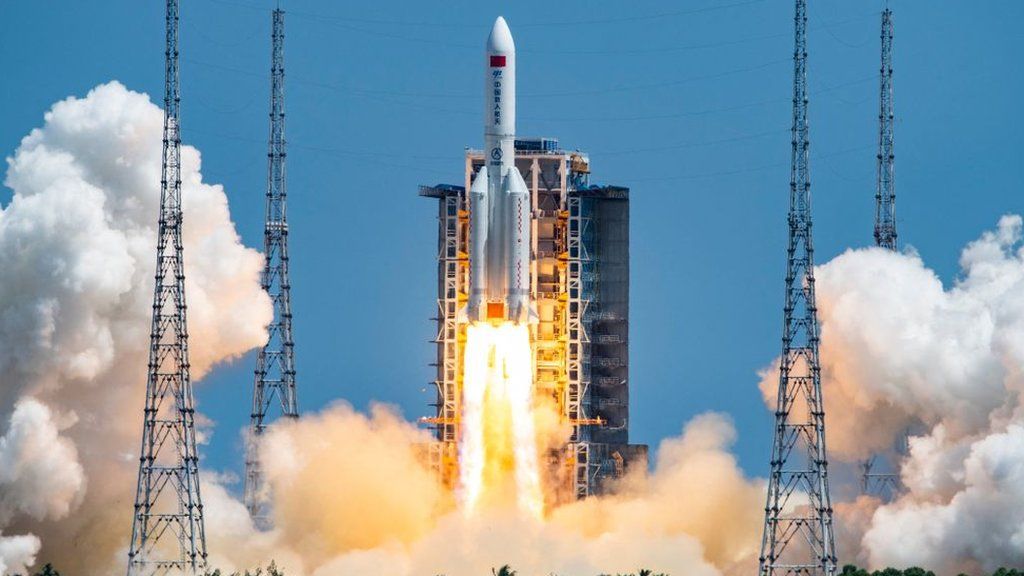ARTICLE AD BOX
By Ella Hambly
BBC News Climate and Science
 Image source, Getty Images
Image source, Getty Images
The rocket lifting off from southern China on July 24, 2022
Debris from a Chinese rocket is expected to crash to Earth in an uncontrolled re-entry this weekend.
The probability of it landing in any populated area is extremely low.
But it has raised questions about how different countries take responsibility for their space junk.
There have previously been calls by Nasa for the Chinese space agency to design their rockets to disintegrate into smaller pieces upon re-entry, as is the international norm.
Recent rockets heading to China's unfinished space station, known as Tiangong, have lacked the capability for a controlled re-entry.
The latest launch was on Sunday, when a Long March 5 rocket carried a lab module to the Tiangong station. The Chinese government said on Wednesday that the rocket's re-entry would pose little risk to anyone on the ground because it would most likely land in the sea.
However, there is the possibility for pieces of the rocket to come down over a populated area, as they did in May 2020 when properties in Ivory Coast were damaged.
The empty rocket body is now in an elliptical orbit around Earth where it is being dragged toward an uncontrolled re-entry.
According to The Aerospace Corporation, a non-profit organisation based in California, re-entry will occur around 0024 GMT Sunday, plus or minus 16 hours.
It's too early to know exactly where the 25 ton chunk of debris will land. The possible area where the debris could fall spans the US, Africa, Australia, Brazil, India and Southeast Asia, according to Aerospace Corporation predictions.
"Regarding the Long March 5 launched several days ago, there is no known (re-entry) plan, which equally has been the case for previous launches of this vehicle," UK-based space-tracking expert Sean Goldborough, director of Northern Space and Security (NORSS), told BBC News.
"The lack of communication, coupled with what could be considered unpredictable results for the previous two launches, is primarily what causes concern."
Designing objects to disintegrate upon atmospheric re-entry is becoming a priority for satellite operators. It's done partly by using materials which have low-melting point temperatures, such as aluminium.
In the case of rockets, this can be expensive, as historically the materials used for housing fuel, such as titanium, require very high temperatures to burn up. The sheer size of such objects is also an issue, especially in the case of the Long March 5, weighing over 25 tons.
Despite this, other space agencies have been designing their rockets to disintegrate into smaller pieces during re-entry ever since large chunks of the Nasa space station Skylab fell from orbit and landed in Australia in 1979.
Last year, following a previous uncontrolled re-entry by the China Manned Space Agency (CMSA), Nasa Administrator Bill Nelson said: "It is clear that China is failing to meet responsible standards regarding their space debris."
"Spacefaring nations must minimise the risks to people and property on Earth of re-entries of space objects and maximize transparency regarding those operations," he said.
Long March 5 rocket before take off in May 2021
The same Long March 5 configuration has launched twice before, once in May 2020 and again in May 2021 carrying different elements of the Tiangong station.
On both occasions debris from the rocket's 'core stage' were dumped back on Earth, in Ivory Coast and the Indian Ocean. These followed a prototype that crashed into the Pacific Ocean back in 2018.
None of these incidents caused injury but did garner criticism from a range of space agencies. On Tuesday Chinese state-run newspaper Global Times accused western media of a US-led smear campaign against Long March-5B .
This latest launch carried the second of three modules to China's space station. The Wentian lab module at 17.9 metres long will be the first of two labs to join the station. China began constructing the space station in April 2021 with the launch of the Tianhe module, the main living quarters.
China hopes Tiangong will be complete by the end of 2022.

 2 years ago
30
2 years ago
30








 English (US) ·
English (US) ·